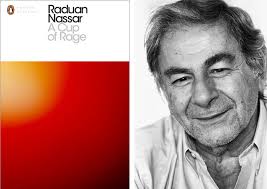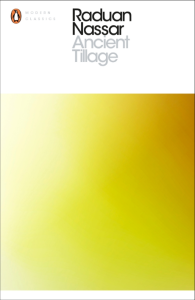Raduan Nassar, “A Cup of Rage” ( Transl. by Stefan Tobler)
 “…I could’ve found plenty of reasons to trip her up, not that I was so naif I demanded coherence, I didn’t expect that of her, I didn’t boast of that myself, only idiots and bastards proclaim that they serve a single lord, in the end we are all beasts born of one and the same dirty womb, carriers of the most vile contradictions, …” ( p.19, A Cup of Rage)
“…I could’ve found plenty of reasons to trip her up, not that I was so naif I demanded coherence, I didn’t expect that of her, I didn’t boast of that myself, only idiots and bastards proclaim that they serve a single lord, in the end we are all beasts born of one and the same dirty womb, carriers of the most vile contradictions, …” ( p.19, A Cup of Rage)
A Cup of Rage is a slim book of 47 pages and seven chapters. Each chapter consists of one long sentence. It is about a pair of lovers — a young female journalist and an older man who inhabits an isolated farm. They spend the night together and the following morning without any warning they tear into each other. It is unexpectedly barbaric and devastating given how a little while earlier they had been so lovingly tender. A Cup of Rage is an extraordinary text for its intensity and the power game between the couple. The book was first published in 1978. Given that women’s movements and feminism were gaining significance in the 1970s the old man’s venomous verbal tirade directed at the emancipated woman/lover followed by the stinging slap he delivers gives the reader a shocking jolt. The unexpectedness of the rage could be seen at face-value as a spat between lovers or as a commentary on the changing social structures and gender equations. Even though I am not familiar with the source language — Portuguese — there is something in the tenor of the translation by Stefan Tobler that makes the story truly magnificent. Sure, there is passion evident in the opening sex scene but the incredible skill of this translation is evident in the energy being carried over to the next day’s incident. Somehow it gets incredibly transmitted in the English text. It has been a while since I read a text that was absorbing to read from the word go.
Raduan Nassar writes these long sentences making one breathless but akin to moments very similar to how we think –flitting from topic to topic, a roller coaster of emotions, going off at a tangent sometimes but somewhere keeping it altogether with a bit of philosophical reflection and analysis. The chapter-long sentence broken occasionally by punctuation moves so seemingly effortlessly. It is like a dance. Fluid. Broken by moments of intensity ( whether in conversation or action) punctuated by moments of such detached reflection bordering on meditation. There are moments when the text is better engaged with as a reader when read out aloud. Stefan Tobler writes in The Independent, “The writing has the sheer unstoppable force of a child’s temper tantrum, and only on a second read – or as an editor or translator – do you see the intricate patterns and repetitions that combine to produce this crushing emotional onslaught. He plays fast and loose with standard syntax and punctuation to convey the turmoil and onward rush of his characters. Most of his pages-spanning chapters in A Cup of Rage are a single long, evocative sentence.” It is no wonder then that as soon as the book finishes you go back to the first page to begin reading it once again. According to an email correspondence I had with Stefan Tobler the first draft of this translation was written almost ten years ago but he returned to edit intensively a year ago. To quote him: ” It was a joy to have something both so precise and so passionate to work with.”
Raduan Nassar is a farmer now and has been for many years. He is considered a modern literary giant of Latin  America despite having written only two novels. Ancient Tillage is his second book although it was published first. The first English translation has been done by Karen Sotelino. Literary techniques employed in both texts are very similar but in A Cup of Rage these come across as a little more sophisticated, probably a testimony to the quality of translation. It is difficult to say since chronologically A Cup of Rage was written after Ancient Tillage but published first in the 1970s. It could be that by the time he wrote the second story the author had experimented more with writing. But there is a distinct difference in the two texts. In A Cup of Rage the interior monologue comes across as a richly textured, passionate and sensual. In Ancient Tillage it is flat and dull with a touch of bewilderment. It could be due to the ages of the protagonists too in the stories — young in Ancient Tillage and old in Cup of Rage — thereby being a remarkable comment on Raduan Nassar’s skill as a writer, the ability to be in character of a young and an old man so wonderfully.
America despite having written only two novels. Ancient Tillage is his second book although it was published first. The first English translation has been done by Karen Sotelino. Literary techniques employed in both texts are very similar but in A Cup of Rage these come across as a little more sophisticated, probably a testimony to the quality of translation. It is difficult to say since chronologically A Cup of Rage was written after Ancient Tillage but published first in the 1970s. It could be that by the time he wrote the second story the author had experimented more with writing. But there is a distinct difference in the two texts. In A Cup of Rage the interior monologue comes across as a richly textured, passionate and sensual. In Ancient Tillage it is flat and dull with a touch of bewilderment. It could be due to the ages of the protagonists too in the stories — young in Ancient Tillage and old in Cup of Rage — thereby being a remarkable comment on Raduan Nassar’s skill as a writer, the ability to be in character of a young and an old man so wonderfully.
His evolution as a writer and experiments with literature are not very well documented since Raduan Nassar sparingly gives interviews. He prefers to be a recluse albeit not in a similar fashion to J. D. Salinger. Stefan Tobler wrote a wonderful profile of the eighty-year-old Brazilian author in The Independent to coincide with the publication of the first English translation of these texts. ( http://www.independent.co.uk/arts-entertainment/books/features/raduan-nassar-became-a-brazilian-sensation-with-his-first-novel-now-published-in-english-the-world-a6877851.html )
I am not surprised A Cup of Rage has been longlisted for the Man Booker International Prize 2016. Read the two novels for a glimpse into the earthy brilliance of Raduan Nassar’s writing.
Raduan Nassar A Cup of Rage ( Transl. Stefan Tobler) Penguin Modern Classics, London, 2015. Pb. pp.50 £5.99. First published as Um Capo de Colera in 1978.
Raduan Nassar Ancient Tillage ( Transl. Karen Sotelino) Penguin Modern Classics, London, 2015. Pb. pp.50 £7.99. First published as Lavoura Arcaica in 1975.
2 April 2016
